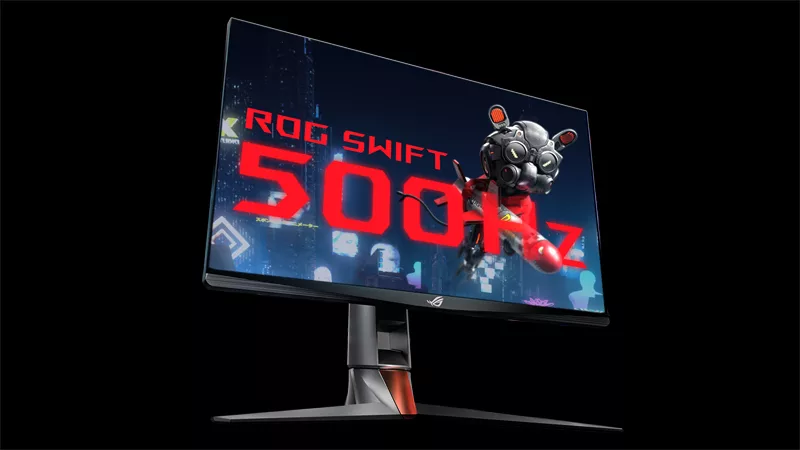Taking a creative vision from the page to the concert stage with art director Jesse Lee Stout
Holographic figures rise up from the stage, massive and looming, at the start of Muse’s Simulation Theory concert in 2019. The illuminations are noisy and distorted: perfect mirrors against the raucous roar of the sold out crowd. It’s a scene straight out of science fiction–one that seems especially otherworldly in 2020, where both the renders and the audience feel distant in a world rocked by an isolating pandemic. But for art director Jesse Lee Stout, it’s another day at work.
 Photo by Hans-Peter van Velthoven
Photo by Hans-Peter van Velthoven
As founder and creative director of Metaform Studio, Stout brings his art to the biggest stages in the world, designing the aesthetics and interactive concert experience for cultural titans like Muse, Drake, and Jay-Z. Despite the grand scale of his creations and the household names he works with, Stout is down-to-earth, with a quick sense of humor about his own fortunes in the industry.
“How I’d describe my job to my grandparents—who are like, “Wait, that’s a job?”—is that I define the aesthetic that accompanies music,” says Stout, over video chat from his home office in Los Angeles, California. “Art direction comes out through creating the look of the stage, the lighting, the look of what a show will be, the press photos that a band does, and the idea behind it—because all of these things communicate to the viewer.”
Visual storytelling in all of its forms, from the page to the concert stage, is at the core of Stout’s creative work, and why ROG was excited to sit down and talk to him about his creative process, designing for the future, and how tech empowers his work as a professional artist.
Crowd control in the cultural moment
When it comes to concerts in 2020, the global pandemic is the elephant in the room. Like many things that were once everyday occurrences in American life, the massive, arena-filling events Stout designs are on pause. “Just before Covid-19, I was pitching a concept that I had for an immersive experience—an immersive theatre meets augmented reality thing. And then, all of a sudden the phrase, “immersive experience” became very toxic, so that’s definitely on hold for a bit,” Stout recounts, wryly. “But we’ll get there!”
No large gatherings means no crowds, no mosh pits, and effectively, no live music. Yet designers like Stout are already at work figuring out next steps and wading through uncharted territory. “Just in the last three or four months, it’s amazing how we’ve gone from ‘This is only going to last 2 weeks’ to seeing companies designing little bubble outfits, little hazmat suits, that you can go see a concert in,” says Stout, “It feels like every 2 weeks we’re starting from the drawing board again.”
After a decade working in the field, Stout is used to designing for change, even on a grand scale. The nature of live shows has a touch of the unpredictable built in. Concerts are all about the moment, and artists always have to evolve to keep up.
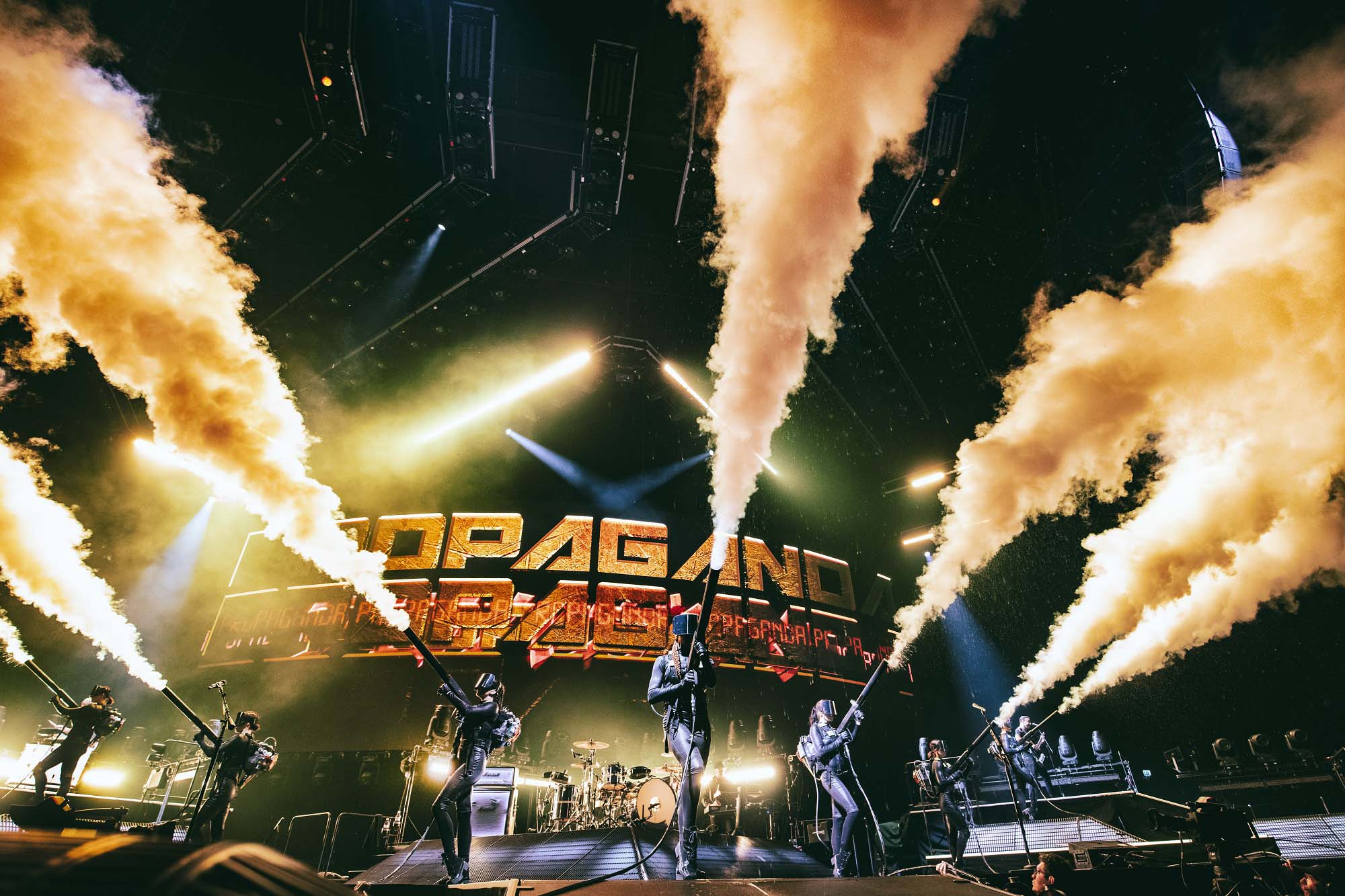 Photo by Hans-Peter van Velthoven
Photo by Hans-Peter van Velthoven
Planning for the unknown, keeping contingencies, and thinking long-term are part of the job. And through seasoned experience, Stout has learned that even in times of tumult, the nuts and bolts of designing a concert stay the same.
Defining a creative vision
It all starts with conversation. Back-and-forth is at the heart of Stout’s work. Getting on the same page with clients is the key to messaging a cohesive vision across a stage and to audiences worldwide. “Any job where I don’t have face time with the artists, there are always issues because I’m not a mind reader and I’m not a magician, and nor is the manager the actual client... At the end of the day, you’re trying to appease one person or one group and you really need good communication.”
Clear messaging is a key part of Stout’s success. “One thing that I’ve learned is to really listen to my client and to watch their mannerisms during meetings because there’s so much that’s communicated during that time.”
Art is often deeply personal, and trying to coax out someone else’s artistic vision can be hard, even for the artist themselves. Listening to someone fully—their expressions, their tone, and even the spaces between their words—is how you get to the root of someone else’s idea.
“It’s deep. It’s somewhere back there that they’re not even conscious of a lot of the time,” Stout says. “Sometimes I’ll hear something off-the-cuff that someone says on the first day and I think, maybe they’ll forget about that? And they don’t! They always come back to it,” Stout explained, laughing. “And once you’ve moved on down the line, there’s just going to be something off. And I’ll think, I should have listened to that!”
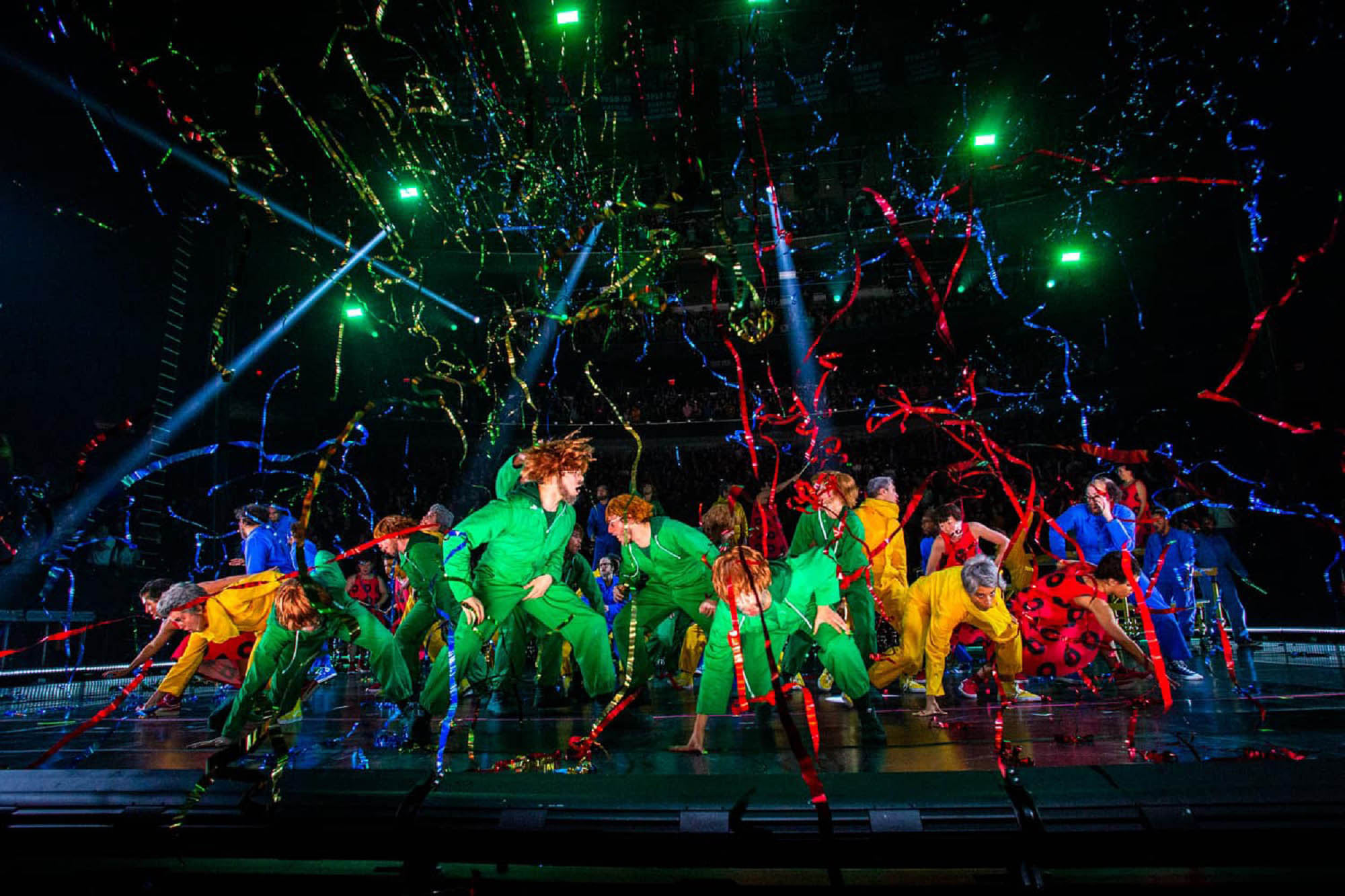 Photo by Phish
Photo by Phish
Setting the concert stage
Once the core concepts have been discussed, Stout starts developing the rest of the aesthetics. Painted in the absolute broadest strokes, no matter what he’s creating, the step-by-step process is consistent. His methodical approach to design stems from his academic and professional background in video art and graphic design.
“At the end of the day—if you’re designing a room for interior design; or architecture, if it’s a show—you’ve got your vision, from your point of view,” he explains. Regardless of whether you’re working in 2D or 3D spaces, “there’s an edge to your sightline, so you’re still looking at a picture. Within that [picture], there needs to be hierarchy in the elements in front of you. There needs to be contrast, there needs to be scale and direction, whether it’s leading your eye one way or another. All of the elements I learned in 2D applications still apply to everything designed in a space.”
As these images solidify, Stout begins creating the all-important “bible” that guides the look and feel of the event. This show bible is the north star for every step of the process that follows, from manufacturing stage props and visuals to coordinating choreography and lighting.
 Photo by Hans-Peter van Velthoven
Photo by Hans-Peter van Velthoven
Building the bible is methodical. “First, I break down the show into acts—usually 4 to 6 acts—and what each act will look like. Then, I identify each song in that act. Will it have dancers? Will it have fireworks? Will it have pyro? Will it have flying things?” Stout says. “Within that, I pull references. I’ll say, this is the dance that I’m looking for, or the movement. These are costumes that I’m looking for, the style, the world that these people are living in.” And after all that, says Stout, “I work with stylists and choreographers to make sure that my idea comes across and that it works.”
Once again, back to that most basic tenet of success: conversation.
In instances when conversation goes astray—when feedback and endless iteration threatens the integrity of a project—the show bible helps keep Stout honest. “It’s important to go back to the root of something. What was our goal in the beginning? What were we trying to achieve? And sometimes those do change along the way, and that’s okay.” Keeping those original goals in mind makes it easier to switch gears when the demands of a project shift.
Crafting the concert experience
Flexibility is designed into all of Stout’s work by necessity. When bands tour, they travel to venues across the world, playing on stages big and small, historic and modern, and everything in between. As an art director, it’s Stout’s job to make sure that his creations translate dynamically to any stage and still bring the music and the performance to life.
“When a band goes on tour, they have a set type of venue that they’re going to be working with, whether that’s an arena that has anywhere between 13,000 to 20,000 people, or amphitheaters, which is maybe at 10,000, and theatres, which are a little smaller, then clubs,” says Stout. “You’re always designing for the limitations of those spaces, or the pros and cons of those spaces.”
Most of the bands Stout works with play stadiums, which can hold anywhere from 80,000 to 150,000 people. “You don’t want a stage or a screen to look really small when somebody is an entire football field away. I create everything proportionately, so that when you’re changing the video art you don’t have to crop anything. Everything just scales up.”
Production managers on the road also ensure that Stout’s designs work in every venue. Equipped with blueprints or photographs of each space, production managers scope out each location and flag any concerns they find. “Sometimes they’ll say ‘This one has a low ceiling, so we’ve got this problem,” or “This venue can’t hang the amount of weight I’ve designed,’” and that will prompt Stout to go to work again to ensure the consistency of his creative vision.
Of course, there’s only so much that can be planned. Concerts are, in themselves, live conversations between the artist and the crowd, so Stout’s work isn’t over until the curtain falls. Every moment of the show is a message that’s up to Stout to communicate clearly. Rehearsals are the closest Stout can get to predicting what the real show will be, and they tend to rank high among his busiest days.
“During rehearsals when we put together a show, we have a short amount of time where everybody comes together and bangs everything out. Everybody has different time slots. The choreographer has the stage for a 5-hour block. Then, automation—the choreography of moving stage pieces—has another block. And then, the band has another block of time. And I’ve got to be there for all those blocks of time, so I get a couple hours of sleep and do it all over again!” he says, grinning.
The business behind art
It’s clear from the tone of Stout’s voice that he loves his job. Visual art has been his creative outlet for as long as he can remember, from his childhood exploits with graffiti to his academic studies in art and design. He even played music in a band, which partially informs his work with performing artists.
But even there, Stout says, “I was always more interested in creating flyers for the show or the merch or talking to my bandmates about like, “Let’s do projections and stuff!” and they were always saying, “Whoa, whoa, we’ve got to write songs first!”
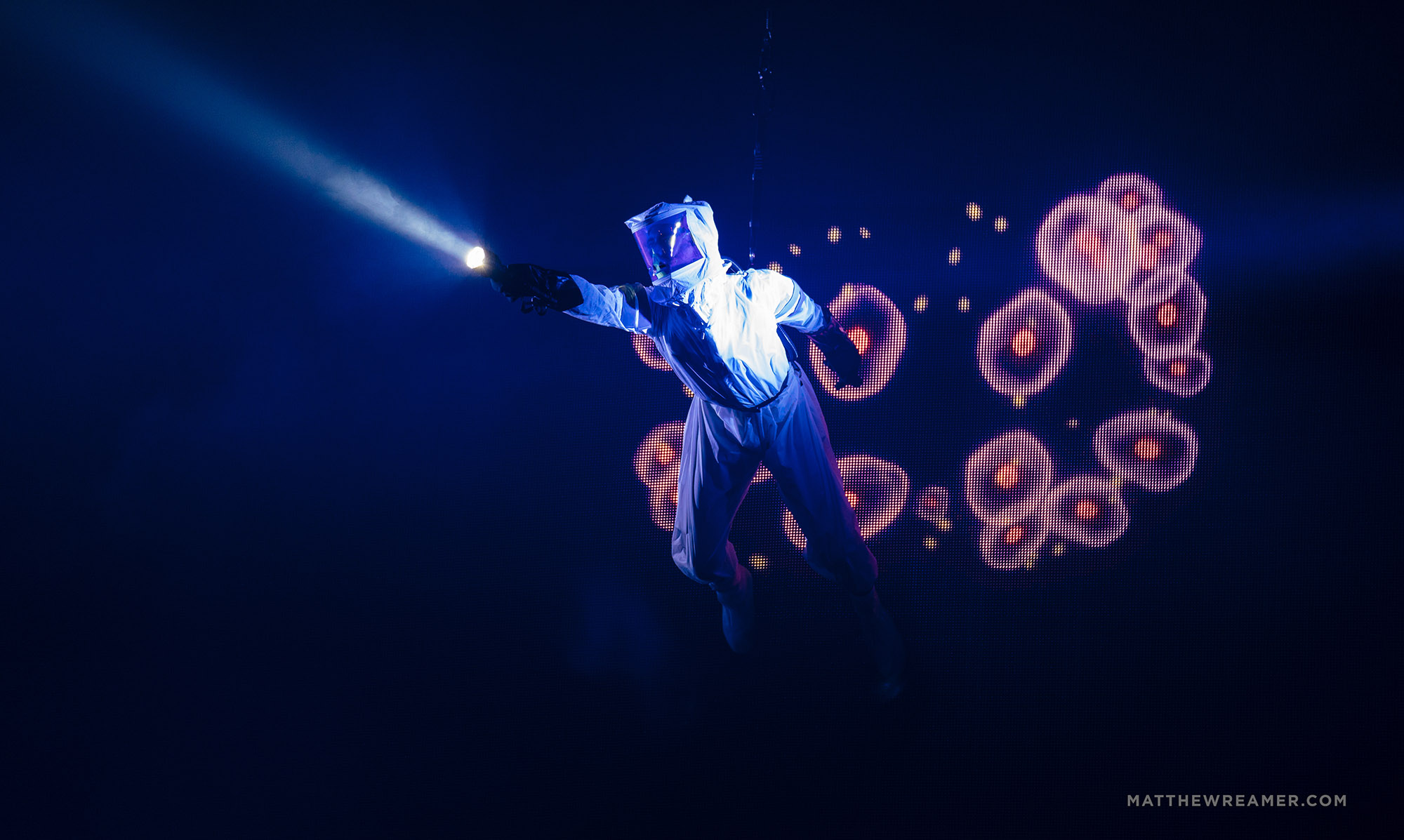
The business side of art, running his own studio, was more of a surprise to him. “Initially I’d gone against the idea, because I was so focused on my art. I hate dealing with contracts and finances. I hate chasing down money. It’s one of the most frustrating things to me and feels like I’m taking away from what I’m good at,” explains Stout.
Ultimately, the freedom to choose his own projects, his own schedule, and defining his own creative output was irresistible. “[At other studios] I kept feeling closed in with what I wanted to do… I really wanted to expand what creative direction for an artist could be—that it didn’t need to be specific to a piece of technology or an environment. That it could shift with whatever an artist needed.”
Stout had to learn the ins and outs of the finances alongside managing clients, collaborators, and his own time. Envisioning new ideas, roughing out concepts, and making last-minute changes all cost money, whether that comes in the form of a designer’s time, expertise, tech resources, or other expenditures. Part of running a business is knowing when to keep going and when to walk away.
Making those kinds of changes is always carefully considered. “It’s a conversation!” Stout says brightly, as he explains how he handles requests for additional iteration. “It’s part of being an adult. Like, do you want to spend more money, so we can explore all we want? Keep the retainer going and explore away until we find it?” If not, he says, “Sometimes something produced is much stronger than something not produced.”
Tools of the trade
On top of figuring out costs for creative effort, Stout has to manage the vast variety of tools needed in the business of professional art. The tools of the trade are wide-ranging and often need to be updated to the latest editions to ensure that Stout stays current and at the top of his game.
“It takes a lot to create these worlds,” Stout says.
When crafting concert stages and other 3D spaces, Stout draws from a deep software bench. SketchUp allows him to communicate ideas quickly with a realistic sense of scale. He employs AutoCAD for technical drawings, and often works with other specialized tools for specific tasks like controlling lighting or prop automation.
Visualizing a show has its own unique software demands. Disguise is the most commonly used video playback software in the concert industry, while Notch is also handy for producing real-time generative video and visual effects. For tracking objects in 3D space, Stout goes to BlackTrax.
“I use [BlackTrax] sometimes to track an artist with spotlights, so that the lights will automatically follow. Or sometimes it creates an effect, like an augmented reality effect, where you’re watching the big screen and wherever the artist moves on stage, you’re seeing the artist onscreen morph.”
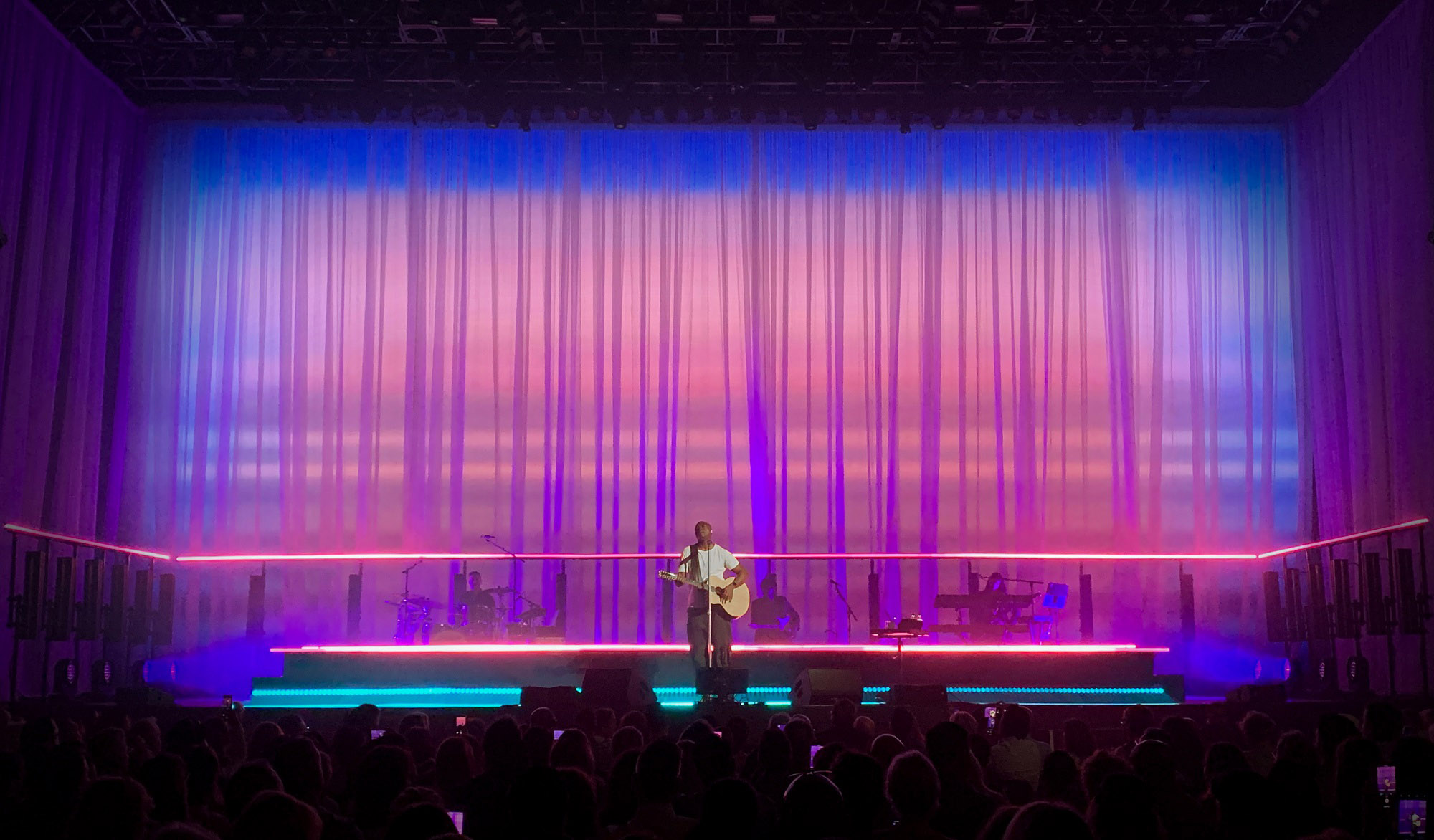 Photo by Jesse Lee Stout
Photo by Jesse Lee Stout
In terms of hardware, Stout keeps things simple: pen and paper for sketches, a laptop and phone for Photoshop and the rest of the Adobe suite. “[Those tools] get almost everything across,” he says. “There have actually been times where I’ve looked to have something created in a professional application that was just far too complicated, too much money, and I wound up finding an app on my phone that can just do the thing.”
When it comes to high tech, Stout cares far more about results than about flash. He’s consistent in emphasizing the importance of working with intention. “You need to know about the latest technologies and know who’s good at it so that you can collaborate with them if your idea warrants using that thing, but I’m never one for using technology for the sake of it, just because it’s the new thing.”
Knowing when to spend, when to save, and staying flexible is key. “It’s important in this industry to work smarter, not harder, and have a workaround for everything. Sometimes you look under the rug and there’s duct tape and staples and bubble gum holding things together, but it works! And that’s all that matters.”
Advice to aspiring artists
Art is a conversation. For Stout, “it’s not just about looking at art, but deconstructing it and understanding it. It’s less important that any aesthetic is cool or trending; what’s the idea being communicated?” Part of success as an artist is communicating your message well. Understanding your message often goes hand in hand with understanding yourself.
“Utilize your “you”—what makes you unique. Everybody’s own background is a different story. For better or worse, no one else has the exact same history… Don’t get preoccupied with your peers’ work, because you’re always going to compare yourself to them. It’s a vicious trap and you’re gonna wind up regurgitating the same stuff,” Stout warns.
“Try to explore things in a different context. You don’t have to reinvent the wheel but take something that you never even thought of as a wheel, that’s round, that changes its context. Take something from pottery and bring that into stage design. Look at the way light hits something else and bring that into a show. Work to shift up your view.”
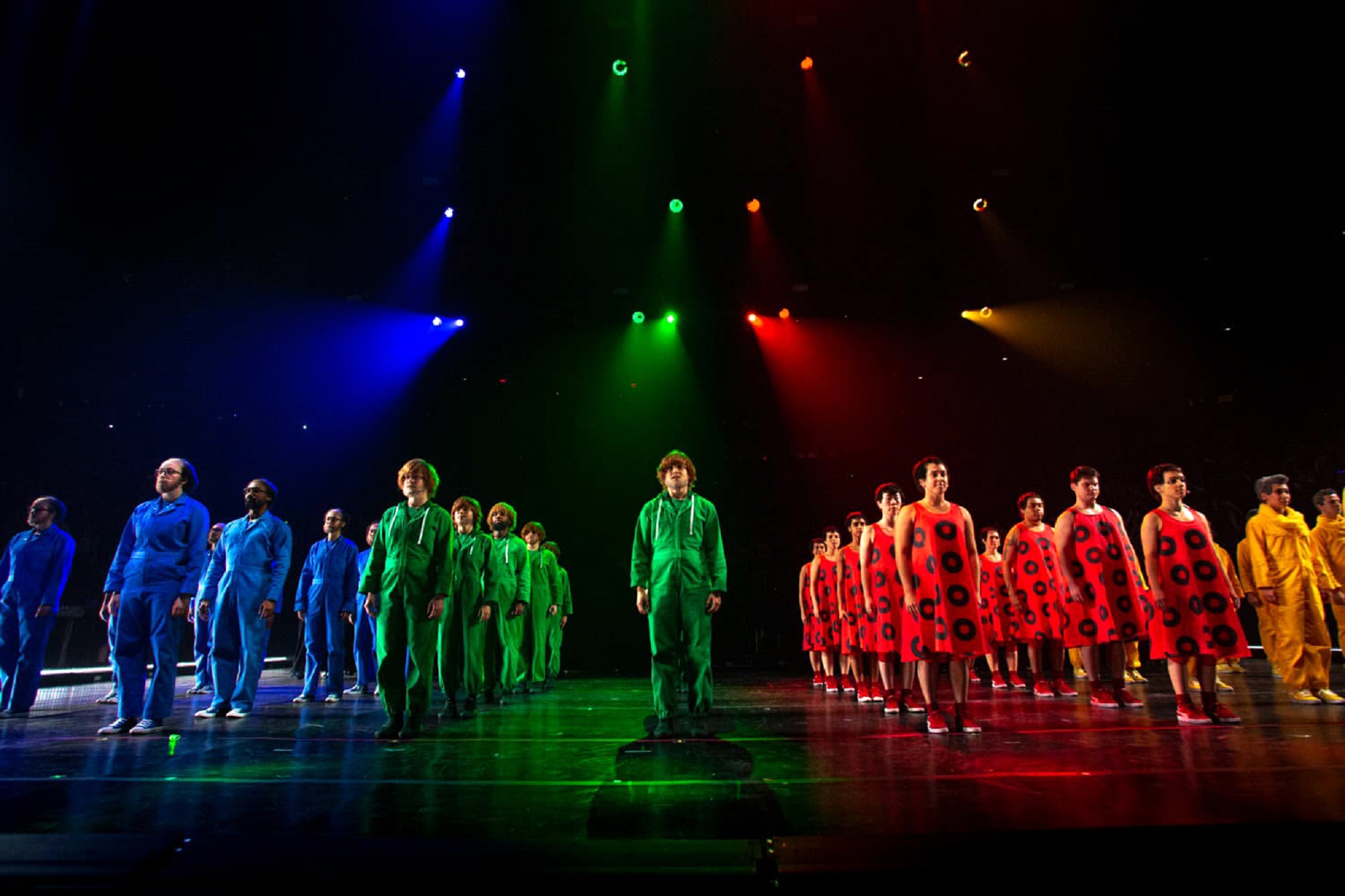 Photo by Phish
Photo by Phish
His last piece of advice illustrates clearly how he’s navigated the responsibilities of being an artist and an entrepreneur: “Always live within your means, so that you have the opportunity to walk away from anything,” he says, insisting that it’s one of the most important lessons he’s learned. “People who are struggling and say, “I need this one gig so I can make the mortgage”—No! Because you’re going to wind up compromising or wasting your time doing something you don’t even like.”
Those creative disappointments, though few and far between, can be the hardest to handle. “When you nitpick something to death, whether it’s your client or yourself, and you’ve gotten so far away from the goal that when you zoom out, it’s not even good anymore? That’s the most defeating thing in my line of work. I just think, aw man, keep the money! I don’t even care!” he says, laughing.
His enthusiasm, his drive, and his commitment to each project is a big part of how Stout has amassed such an impressive portfolio crafting concert experiences that leave lifelong memories for countless audiences around the globe.
Rest assured, when the world is ready to hit play on live music again, Stout will be among the first behind the scenes directing the action and watching the good times roll.
